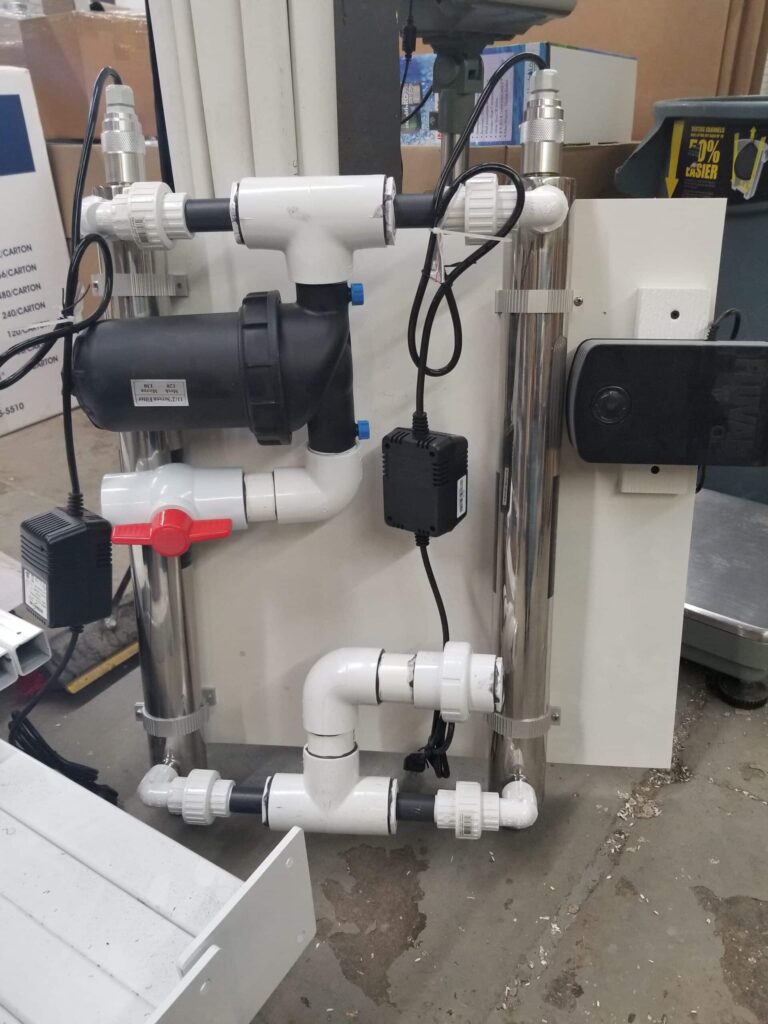SLOs lift solids and keep water level constant
SLOs or Solids Lifting Overflows are a wonderful resource for aquaponic and hydroponic growers, aquaculturists, and anyone with a koi pond. An SLO combines the benefits of an overflow (setting a constant water height) with the benefits of pulling water off of the bottom of the tank, pond, or reservoir (removing settled solids).
An overflow is very simple- imagine a beaver dam across a stream.
The water fills the area behind the dam and eventually runs over the top of the dam. The height of the dam sets the height of the water behind it.
This is very useful for the beaver because he needs a pond with a relatively constant height to survive. The drawback to this arrangement is that solids that flow down the stream are captured behind the dam, eventually filling in the pond until it is muddy and shallow. These solids also consume a lot of oxygen as they decay, making life tough for aquatic organisms that need lots of dissolved oxygen.
The same thing happens in hydroponic catchments, sumps, aquaponic and aquaculture fish tanks and ponds. Unless water is pulled from the bottom of the reservoir, where all of the heavy solids are collecting, the system can get fouled in a hurry.
The solution: SLOs
Enter the Solids Lifting Overflow. The SLO typically consists of two pipes- a drain/overflow pipe and a casing or solids lifting pipe, or one pipe that water flows up, and one pipe that water flow down to drain.
There are many different ways to arrange these pipes to get the same effect, but fundamentally all SLOs operate on the same principle. In my system, I have a large outer pipe that forms the solids lifting pipe, and an inner pipe that is the overflow pipe.
The overflow pipe
The overflow pipe is on the inside of my casing in my SLOs. This pipe drains down, directly into my drainage system. Because it is sealed into my drainage system at the bottom, this pipe sets the water level in my tanks. Unless there is a hole somewhere else in my tank, the water in my tanks can only drain to the top of my overflow pipe. This is a great failsafe measure for any aquaponic or aquaculture practitioner who doesn’t want to come home to a tank full of dead fish left high and dry.
The overflow pipe alone can set our tank water level, but pulls the water from the top of the tank, leaving the solids to collect on the bottom. So, in order to create a SLO from a simple overflow, we must install another pipe to feed the overflow pipe that pulls from the bottom of the tank. In my system, I do this by simply casing the overflow pipe with a larger pipe.
The solids lifting pipe
The solids lifting pipe is open to the atmosphere at the top so as not to form a siphon with the overflow pipe. If its not open to the atmosphere at the top, a siphon will form and can completely drain the tank- defeating the purpose of installing an SLO.
In my system, this is a 4 inch PVC pipe that fits around my overflow pipe and rises around 4-5 inches higher than the top of the overflow pipe. This difference in height forces the water to pull from the bottom of the tank to reach the top of the overflow pipe.
The solids lifting pipe has screened openings at the bottom so that water can flow from the bottom of the tank into the bottom of the solids lifting pipe and up the inside to the top of the overflow pipe.
In this way, my tank volume is set, while solids are lifted from the bottom of the tank. The best of both worlds.
Other configurations
There are many different configurations for SLOs, each with an appropriate application. In its simplest form, it is a simple overflow and solids lifting (casing type) pipe, that allows water to drain directly into the sump below. In others it is a pipe U extending through the tank wall, with a Tee substituted for one of the elbows (open to the air to prevent siphoning), draining to the sump.
SLOs can be a great tool for anyone operating a sump based system.
Want more helpful information?
Check out our videos on drainage and consider installing an SLO in your system. For sump-based systems they’re guaranteed to increase your system health and reduce the chances of a tank draining catastrophe.






